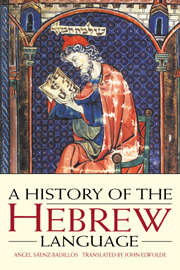Book contents
- Frontmatter
- Contents
- Foreword by Shelomo Morag
- Acknowledgements
- 1 Hebrew in the context of the Semitic languages
- 2 Hebrew, a Northwest Semitic language
- 3 Pre-exilic Hebrew
- 4 Biblical Hebrew in its various traditions
- 5 Hebrew in the period of the Second Temple
- 6 Rabbinic Hebrew
- 7 Mediaeval Hebrew
- 8 Modern Hebrew
- Bibliography
- Index
4 - Biblical Hebrew in its various traditions
Published online by Cambridge University Press: 05 June 2012
- Frontmatter
- Contents
- Foreword by Shelomo Morag
- Acknowledgements
- 1 Hebrew in the context of the Semitic languages
- 2 Hebrew, a Northwest Semitic language
- 3 Pre-exilic Hebrew
- 4 Biblical Hebrew in its various traditions
- 5 Hebrew in the period of the Second Temple
- 6 Rabbinic Hebrew
- 7 Mediaeval Hebrew
- 8 Modern Hebrew
- Bibliography
- Index
Summary
The transmission of Biblical Hebrew
The preservation of classical Hebrew is inseparably connected with how the text of the Bible was transmitted down the centuries. After a long period of formation in which the various texts were expanded, modified, and, after the exile, adjusted in a variety of ways, and in which the palaeo-Hebrew script gradually gave way to Aramaic square characters, the text of each book began to stabilize. Originally, this was not a totally uniform process, as is evident from the variants found in early manuscripts and the versions, but it did become more obvious and thoroughgoing, especially in the Tannaitic period.
By the end of the first or the beginning of the second century CE, the consonantal text seems to have become completely stable, bringing to an end a period of textual diversity, which had arisen due perhaps to the existence of various local texts or more probably to the use of particular versions within different religious or other groups.
Within the Jewish community, awareness of the sacred character of the biblical text, ultimately extending to its smallest details, helped to guarantee its transmission from one generation to another in the home and especially among the community's teachers and religious officers. Long before precise notes about the conservation of the text had been set down in writing, a much older oral tradition had developed in order to ensure the transmission in exact detail of the text, which could not be modified or undergo addition or deletion of a single letter.
- Type
- Chapter
- Information
- A History of the Hebrew Language , pp. 76 - 111Publisher: Cambridge University PressPrint publication year: 1993



